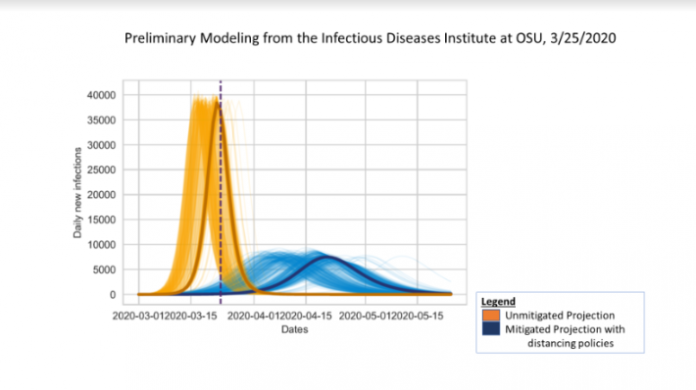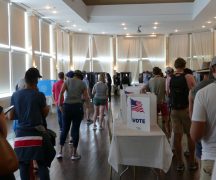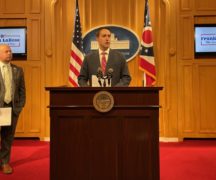Since the new coronavirus was first detected in Ohio, state Department of Health Director Dr. Amy Acton repeatedly emphasizes the need to “flatten the curve” at regular afternoon pandemic briefings.
Meanwhile, a team at Ohio State University’s Infectious Disease Institute turns mounds of discrete data points into models that try to predict how many people will contract and display symptoms for COVID-19, the respiratory disease caused by the new coronavirus, and when.
In other words, they draw those curves we’re trying to flatten.
“This model is attempting to anticipate how many people we’ll see infected the next day,” said Grzegorz Rempala, one of the researchers leading the modeling. “Then it kind of sniffs around to see what would have been the population of your contact networks under that set of parameters of the infection curve for the type of numbers you’re seeing.”
On Thursday (March 26), Acton, as part of her usual afternoon pandemic briefing, unveiled two key findings from the OSU model.
The upside: social distancing, and some of the closures her and Gov. Mike DeWine enacted have successfully slowed the spread of the disease, preventing a massive and untenable burden on the health care system. Acton said the models suggest the moves decreased the impact by between 50% and 75%.
The downside: the researchers predict the epidemic will peak in two to four weeks, with between 6,000 and 10,000 people testing positive for contracting and exhibiting symptoms of the virus each day.
This influx will likely overload hospitals at their current capacity. Shortages of ventilators and personal protective equipment like gloves and masks needed to handle the intake could endanger patients and care providers alike.
Rempala said all told, the model predicts Ohio’s epidemic to yield at between 100,000 and 300,000 symptomatic cases.
“For the next two weeks, maybe two and a half, we’re expecting that the number of daily infections will continue to grow, then it will start slowing down,” he said. “So we’re hoping that the epidemic will peak in about two and a half weeks, maybe three.” (In a follow-up email, he predicted a peak in 2-4 weeks.)
Joe Tien, another researcher leading the team, emphasized the modeling isn’t designed to determine how many people total will become infected. Instead, they’re specifically looking to predict how many will show symptoms of the disease, not just carry it. Those people are the ones at risk of hospitalization or deaths.
“In the immediate timescale, what we’re trying to use from this model is to help planning for preparations for hospitals in the immediate term,” he said.
State officials seem to be listening.
On Friday, DeWine announced ambitious plans seeking to triple the number of Ohio’s hospital and ICU beds. This came after separate modeling from the Cleveland Clinic suggested a peak closer toward the end of April, but with as many with around 10,000 people becoming infected per day.
By Saturday, DeWine urged private labs like LabCorp and Quest Diagnostics to ramp up their testing capabilities, and the FDA to allow Battelle to deploy new technology to sterilize N95 masks worn to shield care providers from the virus.
The end goal: the forecasters at OSU and elsewhere predict how heavy the surge will be, and state officials and hospital administrators figure out how to respond.
Part of the differences between models can come from different assumptions built into the data sets, like how many people someone might interact with. Other differences come from a limited set of data, restrained — especially in the early days of the epidemic — by low testing capacity in Ohio.
“That’s why you’re getting these [projected daily infection] numbers which are changing by 2,000 or so, because if all of a sudden it turns out we have 90 or 100 cases we didn’t know about yesterday, that will change that number,” Rempala said.
The estimates, Rempala said, assume the state would have the capacity to test and confirm. On a state and national level, small scale testing capacity has hindered governments’ responses.
The researchers’ projections clash with President Donald Trump’s urging to have the country “opened up” by Easter (April 12).
The exact meaning of Trump’s phrasing is hazy, but Rempala said Ohio is unlikely to lift some of the more drastic closures in that time frame.
“From our analysis, it doesn’t seem like we are open for business in mid-April,” Rempala said.
On Saturday, Acton compared the epidemic modeling to hurricane forecasters. At first, you know a hurricane is coming in a general region at a general time. As the storm approaches, you get a better sense of who gets hit, when, and how hard.
Tien said he’s glad Ohio has leaders like Acton and DeWine who solicit science, based on empirical methods, and use the findings to determine a response.
“Don’t just guess, don’t do something off emotion,” he said. “These models help guide that.”





